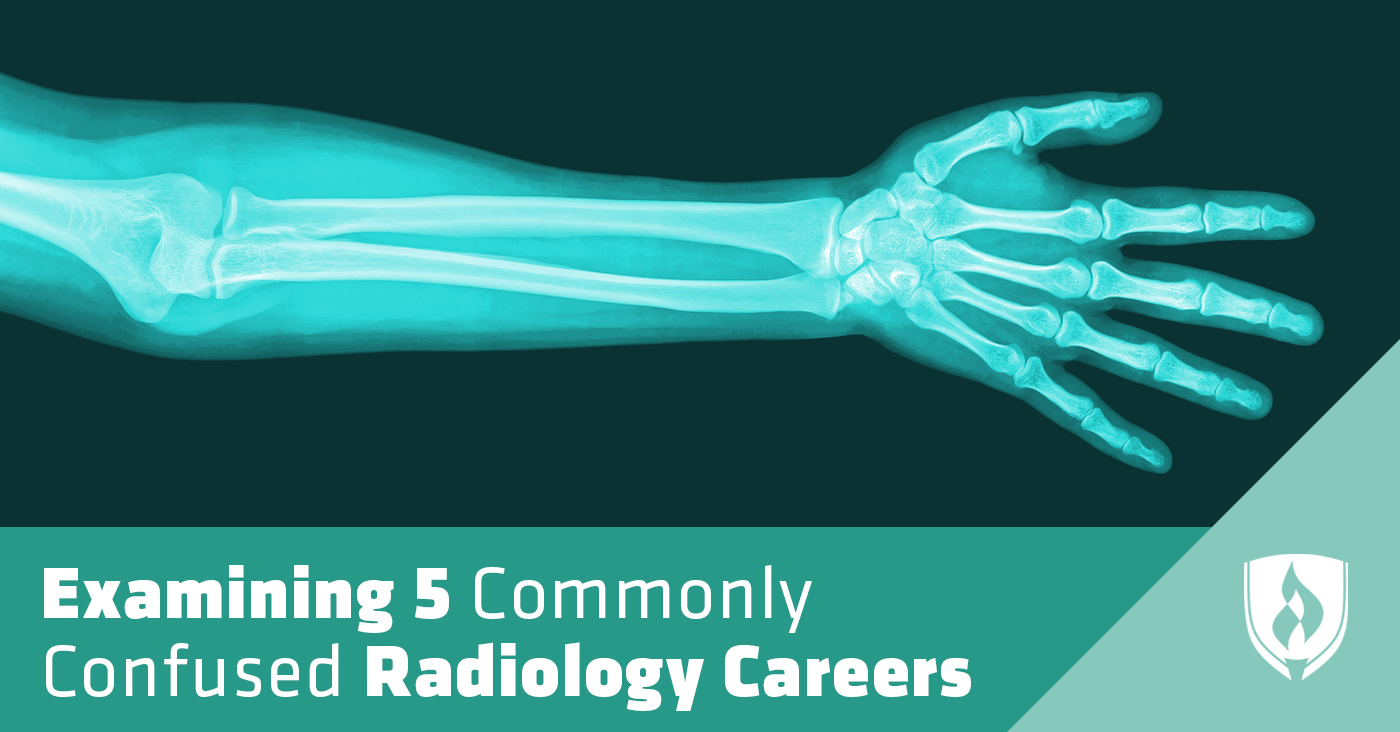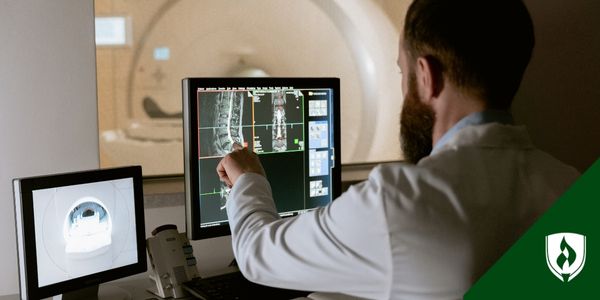
You’ve always been intrigued by x-rays and the science and technology that goes into the process. It was never more than a fascination. But now that you’re starting to consider a new career path you’re curious if it could become more than that.
A career in radiology could be the perfect opportunity to pursue a stable profession you’re passionate about. But there are a lot of radiology careers out there, and you can’t even keep them all straight! How will you know which one is right for you?
Many radiology job titles sound similar, even though they refer to different job duties and career paths. That’s why we did the research to compare five popular radiology careers so you can determine the best option.
Clearing the confusion between similar sounding radiology careers
All radiology professionals work with radiation equipment, but they put those skills to use in different ways in the medical industry. Familiarize yourself with the responsibilities and education requirements for these commonly confused radiology careers.*
1. Radiologic technician
Projected growth (2014 – 2024): 14% (much faster than average)
If you’ve ever had a broken bone, you’ve probably met a radiologic technician. These professionals typically work in hospitals or physicians’ offices and use x-rays to produce the diagnostic imagery physicians examine to determine the best treatment for their patients.
Technicians work directly with patients as they position radiation equipment to capture the necessary images while keeping patients (and themselves) safe from harmful radiation. They’re also responsible for maintaining and troubleshooting their imaging equipment and keeping detailed patient records.
Most radiologic technicians have earned at least an associate’s degree, and some also pursue additional certification.
2. Radiologic technologist
Projected growth (2014 – 2024): 9-13% (faster than average)
Radiologic technologists are commonly confused with their technician counterparts. Like technicians, technologists obtain patient imagery and ensure their radiation equipment is working properly. They also primarily work in hospitals and physicians’ offices.
However, their job duties extend beyond those of a radiologic technician. Technologists analyze and interpret the images they’ve captured so they can consult with physicians about possible diagnoses and treatment options. They also have more opportunities to specialize in areas such as sonography, mammography and bone density, according to the American Society of Radiologic Technologists (ASRT).
Technologists will need to earn a two-year associate’s degree at minimum, but additional licensing is required in some states. Technologists will also need to pass certification tests related to their specialty, and they’ll need to earn continuing education credits to remain certified, according to the ASRT.
3. Radiologic nurse
Projected growth (2014 – 2024): 14% or higher (much faster than average)
Radiologic nurses are registered nurses (RNs) who specialize in radiology treatment. They work with patients who are receiving radiation treatment or are getting MRIs or x-rays for diagnosis purposes. They work closely with patients to make sure they’re comfortable and that they understand the radiation procedures they’ll be undergoing.
Radiology nurses have a wide range of work environments open to them, including hospitals, clinics, home care, nursing care facilities and outpatient centers. They may also choose a sub-specialty of radiology, such as pediatric radiology or ultrasound imaging.
Radiologic nurses must first meet their RN requirements before pursuing a radiology specialty. That means earning a nursing degree and passing their NCLEX-RN exam. RNs may then earn continuing education credits and work a required number of experience hours before taking their Radiologic Nursing Certification Board.
4. Radiation therapist
Projected growth (2014 – 2024): 14% or higher (much faster than average)
Radiation therapists treat cancer and other diseases by delivering targeted radiation treatments to affected areas. They work closely with patients to ensure they’re comfortable and are prepared for the procedures and have a high command over their equipment to ensure the proper dose of radiation is applied.
Most radiation therapists work in hospitals or universities, though specialty hospitals and insurance carriers are also looking to hire these radiation experts. You’ll need an associate’s degree to make the leap into a radiation therapy career, and each state has individual licensing requirements.
5. Radiologist
Projected growth (2014 – 2024): 14% or higher (much faster than average)
Radiologists are licensed physicians who specialize in imaging techniques such as x-rays, mammography, MRIs and ultrasounds, according to the American College of Radiology (ACR).
Radiologists typically aren’t involved with actually capturing the radiation imagery. Their work is done behind the scenes where they interpret images and define a comprehensive diagnosis and treatment plan. They’re responsible for explaining the diagnosis to patients and their families and working with them to ensure they understand their treatment options.
Radiologists work everywhere from hospitals and clinics to diagnostic labs and scientific research facilities. Most radiologists choose to specialize in a certain area, such as pediatric radiology, emergency radiology, gastrointestinal radiology and breast imaging.
Aspiring radiologists must first complete their bachelor’s degree, medical school and residency before taking the radiologist certification exam, which is administered by The American Board of Radiology.
Which radiology career is right for you?
Now that we’ve demystified the specifics of these five radiology careers, you’re one step closer to identifying your ideal position in the radiation field.
You’ve also likely heard about the unique health risks associated with working in potentially hazardous environment. Don’t let that stop you from considering one of these radiology careers. Educate yourself by reading our article: What Healthcare Workers Need to Know About Radiation Effects.
RELATED ARTICLES:
- 5 In-Demand Healthcare Jobs that Don’t Require a Degree
- 6 Desirable Direct Patient Care Jobs for Extroverts
- What You Need to Know About the New Mammogram Guidelines
*Bureau of Labor Statistics, U.S. Department of Labor, Occupational Outlook Handbook, [information accessed March 2016] www.bls.gov/ooh/. Employment conditions in your area may vary.
**Data for radiologic nurse reflects the DOL’s data for registered nurses. Salary and growth information for RNs with this specialty may vary.




